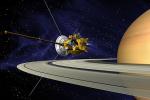Local link to Saturn probe
At least one person in Adelaide is paying very close attention to the current, spectacular spacecraft mission to Saturn. Miguel Perez Ayucar from Spain is attending the International Space University (ISU) program here in Adelaide with a scholarship from the European Space Agency. He's studying the nine-week course along with more than 100 other students from around Australia and the rest of the world. While attending lectures and working on team projects in Adelaide, Miguel's mind is not just thinking about space in the classroom - he's also thinking about the real-life Cassini-Huygens mission to Saturn and its moons, of which he's playing an important part. Miguel is a 27-year-old engineer who has been working on the telecommunications for the Huygens probe, which is the European Space Agency part of the mission. Cassini-Huygens entered Saturn's orbit on July 1 and has been sending some incredible images of the planet, its rings and moons back to Earth. "Where was I when Cassini-Huygens entered into Saturn's orbit? I was in Adelaide, Australia!" Miguel said. "[My] nerves were impossible to control, in fact I had to leave one of the lectures to follow online the events happening," he said. Connected via email and phone to his colleagues in the northern hemisphere, Miguel was able to stay in touch with the distant mission. "In one of the lectures I made a small status report to the rest of the ISU students, although no data had returned yet - it was travelling through the solar system from Cassini. "After knowing that everything had developed nominally and we were in orbit around Saturn, I was so excited! "When [the] first images of Cassini arrived I was astonished by the beauty of the rings and the complex structure. But I was already thinking [of] the first images that were to be taken next day during the first Titan fly-by. Those observations are crucial for our team to validate the current models of Titan's atmosphere and refine some of the mission parameters, mainly for the fierce entry into Titan's world." The reason why this is so important is that Titan - Saturn's largest moon - is the destination of the Huygens probe, an "atmospheric robotic laboratory that will plunge into the murky atmosphere of Titan". "I am currently working on the telecommunications part of the mission, so it is my job to ensure that all the data gathered from the instruments on-board Huygens are successfully transmitted back to Earth. In normal missions, the Science Operations team is responsible for the day-to-day planning of the scientific observations. However, Huygens is a very special mission, because there is only one observation slot, the descent into Titan, which lasts only two and a half hours," Miguel said. "For the last 18 months, we have been refining the telecommunications so that we can be sure the data will be successfully transmitted. One of our problems is the 'Doppler' effect (the same effect which causes the sound of a police car siren to change as it speeds past). Many things could be done to help us minimise the Doppler effect if we had the spacecraft here with us, but since it is already in space, it is very difficult to make adjustments. All we can really do is change the trajectory or change the software. "We will be refining our analyses of Huygens right up until the last minute." Working on this aspect of space exploration had long been a dream for Miguel. The realisation of all his - and the team's - hard work is getting nearer, with the Huygens probe due to separate from Cassini on Christmas Day. The probe's entry into Titan's atmosphere is scheduled for January 14, 2005. "When I was a child, I was fascinated by the stars, and when I got my first telescope, I remember seeing Saturn's rings, which was incredible," Miguel said. "Huygens, the first probe to land on a world in the outer solar system, will be doing unique observations of the moon Titan, and could even find the basic building blocks of life there. For me, that is the most fascinating thing about the mission." The ISU summer session program is being jointly hosted by the three South Australian universities - Adelaide, UniSA and Flinders - until August 27. www.isunet.edu
|





